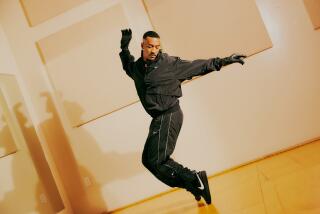DANCE REVIEW : Hyper-Physical ‘Industrial’ Program Flexes Its Muscles
- Share via
Add lanky, Toronto-born Joel Christensen to the growing list of locally based, daredevil, dance-till-they-drop athlete-choreographers headed by Mehmet Sander and Stephanie Gilliland.
Long stretches of Christensen’s hyper-physical, five-part “Industrial Dance” program, Sunday at the Dynarski Theater in Hollywood, may have swerved into sudden-death aerobics, but the best moments confirmed the existence of a spunky intelligence to match his gleaming muscles.
Christensen currently performs with the Sander company, and the family resemblance remained unmistakable in his most recent pieces, “Tired” and “Blocks,” both of which involved the manipulation of heavy objects. But while Sander has defined himself as a structuralist gay-Ninja, Christensen staked his claim as an absurdist entertainer.
Bounding atop 20 car tires in the former piece or toting huge wooden cubes in the latter, he never appeared engulfed by a metaphoric process (Sander’s specialty). Instead, the tasks seemed whimsical personal showcases: the postmodern equivalents of Fred Astaire dancing with a coat-rack in “Royal Wedding” or with ship machinery in “Shall We Dance.” No, he’s not at that level yet, but give him time.
Unfortunately, the climactic duet-with-tire fell apart completely on Sunday and the phenomenal hopping solo “Boing” went nowhere conceptually. Like all of Christensen’s works on the program, it lacked an evident through-line or sense of internal logic shaping the array of impressive and sometimes imaginative physical effects.
Earlier, more conventional group pieces about dance-making and war explored pre-existing vocabularies with uneven results. The former “Work in Progress: Work in Progress” made a forgettable formal etude the climax of scattershot portrayals of choreographic soul-searching and self-doubt.
The latter incorporated robot-like military strides a la “The Green Table” and even used the same momentary soldier-collapses that Paul Taylor developed as a motif in his “Company B.” Christensen calls his piece “Zero” but maybe it should be retitled “Company C-Minus” instead.
More to Read
The biggest entertainment stories
Get our big stories about Hollywood, film, television, music, arts, culture and more right in your inbox as soon as they publish.
You may occasionally receive promotional content from the Los Angeles Times.










